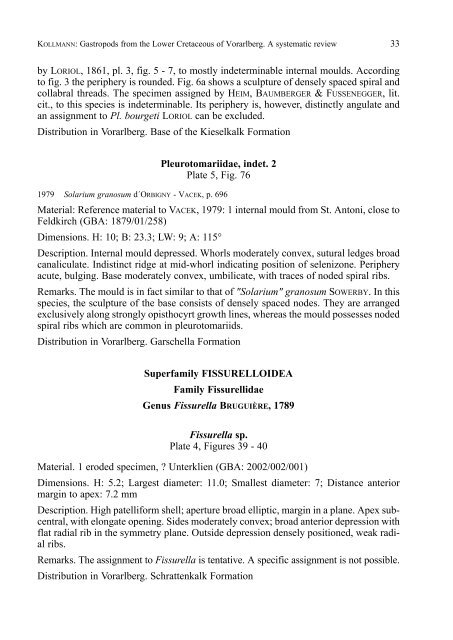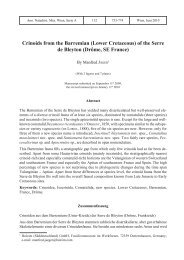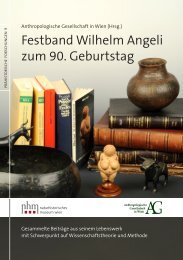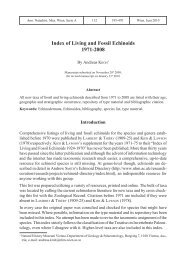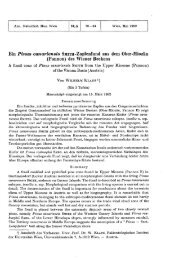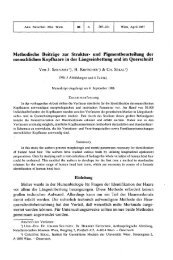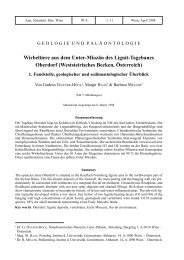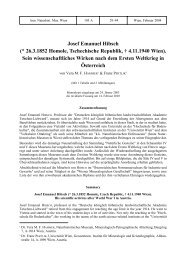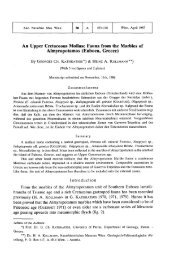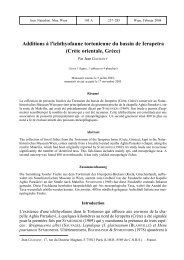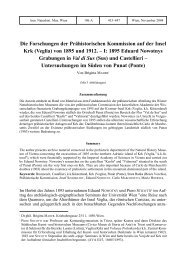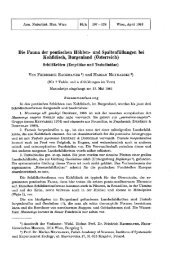Gastropods from the Lower Cretaceous of Vorarlberg, Austria. A ...
Gastropods from the Lower Cretaceous of Vorarlberg, Austria. A ...
Gastropods from the Lower Cretaceous of Vorarlberg, Austria. A ...
You also want an ePaper? Increase the reach of your titles
YUMPU automatically turns print PDFs into web optimized ePapers that Google loves.
KOLLMANN: <strong>Gastropods</strong> <strong>from</strong> <strong>the</strong> <strong>Lower</strong> <strong>Cretaceous</strong> <strong>of</strong> <strong>Vorarlberg</strong>. A systematic review 33<br />
by LORIOL, 1861, pl. 3, fig. 5 - 7, to mostly indeterminable internal moulds. According<br />
to fig. 3 <strong>the</strong> periphery is rounded. Fig. 6a shows a sculpture <strong>of</strong> densely spaced spiral and<br />
collabral threads. The specimen assigned by HEIM, BAUMBERGER & FUSSENEGGER, lit.<br />
cit., to this species is indeterminable. Its periphery is, however, distinctly angulate and<br />
an assignment to Pl. bourgeti LORIOL can be excluded.<br />
Distribution in <strong>Vorarlberg</strong>. Base <strong>of</strong> <strong>the</strong> Kieselkalk Formation<br />
Pleurotomariidae, indet. 2<br />
Plate 5, Fig. 76<br />
1979 Solarium granosum d´ORBIGNY - VACEK, p. 696<br />
Material: Reference material to VACEK, 1979: 1 internal mould <strong>from</strong> St. Antoni, close to<br />
Feldkirch (GBA: 1879/01/258)<br />
Dimensions. H: 10; B: 23.3; LW: 9; A: 115°<br />
Description. Internal mould depressed. Whorls moderately convex, sutural ledges broad<br />
canaliculate. Indistinct ridge at mid-whorl indicating position <strong>of</strong> selenizone. Periphery<br />
acute, bulging. Base moderately convex, umbilicate, with traces <strong>of</strong> noded spiral ribs.<br />
Remarks. The mould is in fact similar to that <strong>of</strong> "Solarium" granosum SOWERBY. In this<br />
species, <strong>the</strong> sculpture <strong>of</strong> <strong>the</strong> base consists <strong>of</strong> densely spaced nodes. They are arranged<br />
exclusively along strongly opisthocyrt growth lines, whereas <strong>the</strong> mould possesses noded<br />
spiral ribs which are common in pleurotomariids.<br />
Distribution in <strong>Vorarlberg</strong>. Garschella Formation<br />
Superfamily FISSURELLOIDEA<br />
Family Fissurellidae<br />
Genus Fissurella BRUGUIÈRE, 1789<br />
Fissurella sp.<br />
Plate 4, Figures 39 - 40<br />
Material. 1 eroded specimen, ? Unterklien (GBA: 2002/002/001)<br />
Dimensions. H: 5.2; Largest diameter: 11.0; Smallest diameter: 7; Distance anterior<br />
margin to apex: 7.2 mm<br />
Description. High patelliform shell; aperture broad elliptic, margin in a plane. Apex subcentral,<br />
with elongate opening. Sides moderately convex; broad anterior depression with<br />
flat radial rib in <strong>the</strong> symmetry plane. Outside depression densely positioned, weak radial<br />
ribs.<br />
Remarks. The assignment to Fissurella is tentative. A specific assignment is not possible.<br />
Distribution in <strong>Vorarlberg</strong>. Schrattenkalk Formation


